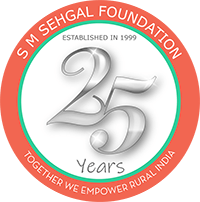By Shweta Kapoor
Rajasthan is the state with the most people affected with fluorosis. 1 Haryana’s Nuh district, being close to Rajasthan, faces the same issue. Fluorosis is a crippling and painful disease caused by the intake of fluoride. Fluoride can enter the body through drinking water, food, toothpaste, mouth rinses and other dental products, and drugs and fluoride dust and fumes from industries using fluoride containing salt and hydrofluoric acid.
A majority Haryana’s population uses groundwater for domestic, irrigation, and industrial purposes. Due to the high concentration of fluoride in groundwater, dental fluorosis has become a common disease in the state, and symptoms of skeletal fluorosis are prominent among adults in several districts of Haryana. But people in Nuh are unaware of the symptoms or causes of fluorosis and have neglected the issue for a long time.
Community radio Alfaz-e-Mewat has worked in the region since 2012 to bridge the communication gap and provide a platform to the people to address their concerns and discuss their problems on radio. A listener feedback program titled “Tere Mere Mann Ki Baat” broadcasts listener feedback and airs grievances shared by the community. Radio staff screens the 50+ recorded calls the station receives daily and compiles them for the episode. When the team received a call from a nearby village, Khedi Khurd of Nagina block, Nuh, about a persistent problem of joint and dental pain among the villagers, they took special note of the issue.
As the conversations continued, the team simultaneously consulted with the medical team at Al-Aafia Civil hospital, Mandikheda, who agreed to visit the village to check on the complaints. The district-level fluorosis consultant visited the village and found the complaints to be true and asked teachers of the village school to convince parents to bring their children to the general hospital for further diagnosis and treatment. He took water samples from the village that showed the particles per million (ppm) at 14 against the normal permissible value of 1 ppm.
The school in Khedli Khurd took responsibility, and all the children went through a thorough check up at the civil hospital. The result of one listener’s proactive action to share a grievance led to identifying the magnitude of the problem and subsequently taking remedial action. Alfaz-e-Mewat played a key role in helping to reach the right stakeholders, bring their problems into the public domain, and seek appropriate solutions.
1 https://medium.com/@fluorideindia/the-state-of-fluoride-in-india-83d6b4373e87
Dispelling myths and finding solutions
Sahil, a twelve-year-old boy, has a disfigured leg from a genetic disorder. A doctor from a nearby village had asked to operate on the leg, but Sahil’s mother feared that an operation might make it worse. Her fear illustrates the need to spread greater awareness among the people to help them overcome false beliefs about medical treatments so they will reach out for medical help for their children.

In order to build awareness about fluorosis, the Adaptive Technologies-water team at Sehgal Foundation is testing water samples from four locations in each village across all blocks of Nuh to assess areas with high incidences of fluorosis. Together with the community, the team is now promoting the plantation of moringa and the intake of right nutrition rich in calcium, iron, vitamin C, and antioxidants to prevent further deterioration of patients suffering from fluorosis. Communication materials and information dissemination through the Citizen Information and Support Center, a toll-free helpline for villagers in Nuh, along with community radio programs, plays, and jingles are driving home the message to overcome the looming fluorosis and dispel myths related to fluorosis.
Finally due attention is being drawn to the long-standing issue of fluorosis that is prevalent in the community. Community media continues to play a vital role in highlighting such needs and serving as a pulse of the community.
(Shweta Kapoor, student of bachelor in business administration, IP University, interned with the S M Segal Foundation in the month of June 2018)


